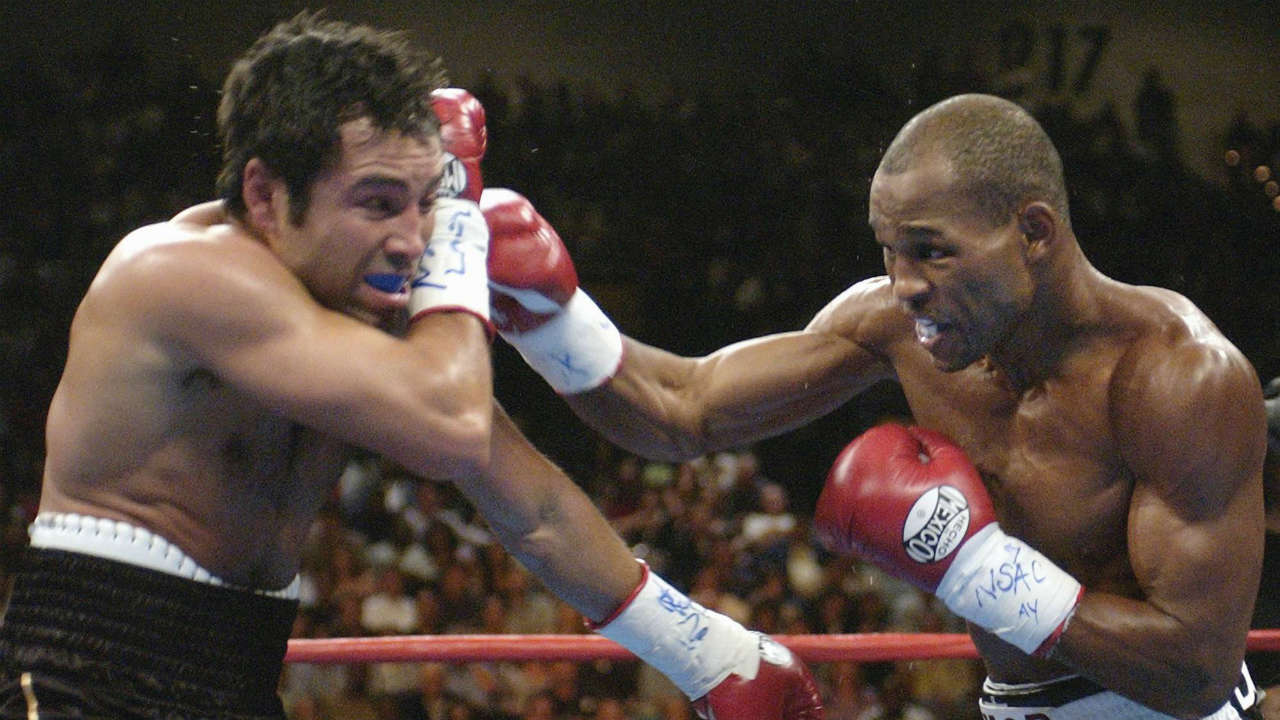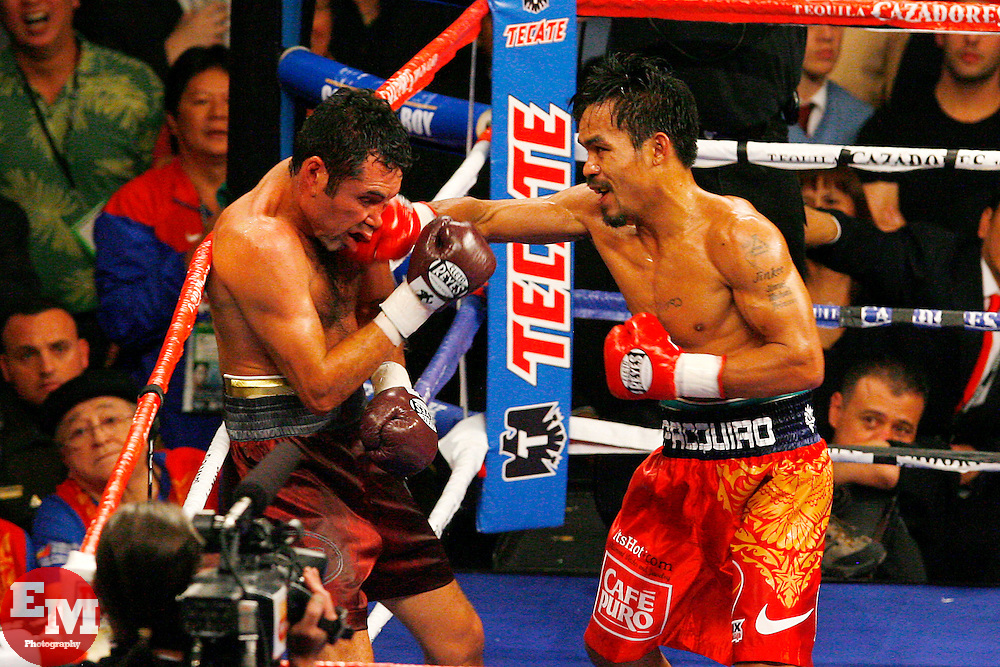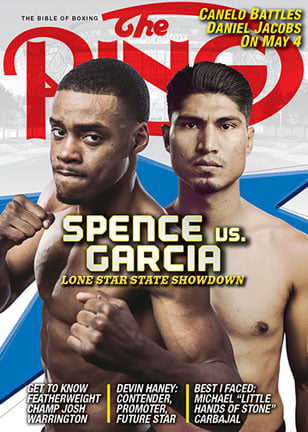David vs. Goliath: A boxing history lesson

In boxing an old adage “A good big ‘un always beats a good little ‘un” has been substantiated countless times throughout history. However the contrary is also true.
On Saturday, we’ll witness the latest in a long line of “David vs. Goliath” match-ups when Errol Spence Jr. puts his IBF welterweight title on the line against WBC lightweight beltholder Mikey Garcia, who will be bidding to win a world title in a fifth weight class.
Garcia and Spence are rated No. 7 and No. 10 by The Ring magazine respectively in its pound-for-pound rankings. Both combatants are extremely regarded by boxing insiders and fans alike, all of which makes their meeting even more intriguing.
Will Spence’s greater physicality and size carry him to victory or will Garcia’s boxing brain steer him to a huge win?
Interestingly Roberto Duran and Shane Mosley made the same leap from lightweight to welterweight when they upset Sugar Ray Leonard and Oscar De La Hoya respectively, while Benny Leonard was disqualified when he attempted the same feat against Jack Britton.
Here we look at some examples of other previous attempts of renown. This list is by no means definitive and is simply designed to give examples of each side winning.
Size matters…
October 16, 1909 – Jack Johnson KO 12 Stanley Ketchel: Ketchel was the reigning middleweight champion and elected to jump to heavyweight to challenge Johnson. Johnson weighed in at 205½-pounds, while Ketchel came in at 170¼. Legend suggests both men, who were apparently friends, agreed to drag the fight out over the full 20 rounds, so fans would go to their local theaters to watch the replay. However in the 12th round, Ketchel saw an opening and dropped the bigger man with a looping right hand. When Johnson rose, Ketchel went for the finish. Big mistake. Johnson took umbrage at the liberty taken and promptly knocked Ketchel out cold with a devastating right hand. Ketchel lost several teeth from the brutal knockout, two of which were embedded in the champion’s glove.
November 18, 1970 – Joe Frazier KO 2 Bob Foster: Foster had won the light heavyweight title two-and-a-half years earlier and left a trail of destruction, winning all 11 interim bouts inside the distance. He had no peers at 175 pounds and set about challenging for the biggest prize in sports. “We were all friends; this is all business,” Foster told The Ring prior to his passing. “There was no big money in my division; I could make a $100,000 but them guys were making $300,000…I told (Muhammad) Ali and Frazier, ‘Give me a chance to make that big money,’ and they did.” Foster weighed 188 while Frazier stepped on the scale at 209. Foster enjoyed a good opening round, even buzzing Frazier; however that changed quickly. “I got hit by that left hook and I don’t remember nothing else after that!” said Foster, laughing. “I was in the dressing room putting on my shoes; one of my trainers pulled them off and I’m putting them back on and he said, ‘What are you doing?’ I said, ‘I’m getting ready to fight.’ He said, ‘Bobby, the fights over with.’ I said, ‘What do you mean?’ He said, ‘He knocked you out.’ I said, ‘On national TV?’ He said, ‘Yeah.’ And I started crying, ‘Oh God; everybody saw me get knocked out.'” (Laughs)

Aaron Pryor (left) and Alexis Arguello. Photo courtesy of ESPN.com
November 12, 1982 – Aaron Pryor TKO 14 Alexis Arguello: Arguello was in search of a world title in a then-unprecedented fourth weight class, while Pryor was fighting for respect. Pryor had been scheduled to face Sugar Ray Leonard; however boxing’s golden boy suffered a detached retina and retired. Without the big payday available, Pryor instead signed to face the pride of Nicaragua. Both men had their successes in a terrific all-action encounter. After 13 rounds, Pryor, the pre-fight underdog, was ahead 127-124 on two of the scorecards, while the third had Arguello up 127-125. “He boxed and he punched with me in (the first) fight and a lot of people didn’t see what he was doing,” Pryor said. “It was a great fight; it went 14 rounds and he got stopped in the 14th but up until then, it was anyone’s fight. Alexis Arguello was all class.” The fight was later tinged with controversy when it was revealed that Pryor’s trainer Panama Lewis asked his second assist between the 13th and 14th rounds to, “Give me the other bottle, the one I mixed.” The now infamous “black bottle” appeared to give Pryor a new spark of life, as he charged to victory. Pryor and Lewis always maintained their innocence. In part due to the murky nature of the first meeting as well as the excellent spectacle put forth by both combatants, the two met in a rematch 10 months later. This time Cincinnati’s finest won in 10 rounds.
https://www.youtube.com/watch?v=DaESioM03g4
June 15, 1984 – Thomas Hearns KO 2 Roberto Duran: Duran was a fearsome former three-division world champion seeking to add to his already impressive resume. Seven months earlier he had given middleweight king Marvin Hagler all he could handle, narrowly dropping a close unanimous decision. “Manos De Piedra” decided to drop back to 154 pounds to face Hearns, who was in the thick of his prime. Though there was nothing between them on the scales, Hearns held a six-inch height advantage and a mammoth 12-inch reach advantage. In the least competitive fight among the fantastic “Fab Four” series, Hearns lived up to his nickname “The Hitman,” dropping Duran twice in the opening round. A weary Duran walked to the neutral corner and had to be guided back to the correct corner by his trainer. The onslaught continued into the second when Hearns landed a perfect right hand, Duran pitched face-first to the canvas, where he was knocked out cold for the first time in 83 fights. “It was very special,” Hearns said of blasting the great “Hands of Stone.” “Nobody ever did that (to him). I threw a whole lot of great punches (in my career) – a lot of them had that impact; some had a little more impact.”

Bernard Hopkins (right) vs. Oscar De La Hoya. Photo credit: Laura Rauch/Associated Press
September 18, 2004 – Bernard Hopkins KO 9 Oscar De La Hoya: Three months after achieving his goal of winning world titles in six weight classes, De La Hoya dared to be great and fought the No. 1 middleweight in a unification for all the marbles. De La Hoya used his greater box-office stature to bring the weight limit down to 157 pounds. To show it wasn’t a problem, the always cerebrally-savvy Hopkins came in at 156, while the “Golden Boy” was a pound less. Hopkins was very aware of De La Hoya’s ability and didn’t rush in like a bull at a gate, instead patiently biding his time, waiting for the opening. “I had to chase De La Hoya down. He came up from junior middleweight. He was the smaller guy; I was the bigger guy,” acknowledged Hopkins. That moment came in the ninth round when “The Executioner” landed a debilitating left hook. De La Hoya remained on his knees, banging the canvas in agony. He was counted out and Hopkins collected a career-high $10 million and made the 19th successful defense of his middleweight title.
A good big ‘un always beats a good little ‘un: Joe Louis KO 8 Billy Conn, Joey Maxim RTD 13 Sugar Ray Robinson, Muhammad Ali KO 8 Bob Foster, Carlos Monzon RTD 6 Jose Napoles, Salvador Sanchez TKO 8 Wilfredo Gomez, Terry Norris TKO 4 Meldrick Taylor, Lennox Lewis D 12 and UD 12 Evander Holyfield, Bernard Hopkins TKO 12 Felix Trinidad, Nicholas Walters TKO 6 Nonito Donaire.
…or does it?
https://www.youtube.com/watch?v=BdhyG0XcGcA
May 18, 1965 – Fighting Harada SD 15 Eder Jofre: Jofre had won the inaugural WBA and WBC titles in 1962 and 1963 respectively and ruled the bantamweight division with an iron fist, often on the road, stopping his title challengers, while Harada had won 11 of 12 outings since losing his flyweight title, convincing Japanese pay-masters to bring Jofre to their country. Harada fought at a frenetic pace and built an early lead and Jofre came back into the fight as it wore on but the slow start was to his detriment on the scorecards, which saw Harada win a split decision. “I am most proud of the fact that I was able to beat a great champion like Jofre,” Harada said. “When I challenged him for the first time in 1965, no one predicted that I would beat the unbeaten champion and it actually was a tough fight. I had moments where I almost had him out (the fourth round) but there were moments where he almost had me out (the fifth round). It was like a dream to beat Jofre.” Jofre isn’t so appreciative of his former rival. “Honestly I won that fight and won well,” Jofre said defiantly. “I’m not saying that; everyone except the judges saw who won the fight. Japanese people on the streets cheered me (as) the winner. That attitude helped me contain the pain of losing my title and unbeaten record. I had great support from my family and all the Brazilian people. The fight was hard at first because Harada was very fast and had a lot of energy but he also held me a lot. Because of the height difference, I took many headbutts. The judges didn’t take that into account; that hurt me a lot. What I like to remember is how well the people in Japan treated me with sympathy, great affection and friendship. I have great regard for the Japanese people.” The two met a year later, again in Japan. Harada repeated his win, this time by unanimous decision.

Sugar Ray Leonard (right) vs. Donny Lalonde
November 7, 1988 – Sugar Ray Leonard TKO 9 Donny Lalonde: Lalonde had won the WBC light heavyweight title a year earlier, while Leonard made the unparalleled leap from middleweight, ending his latest retirement, which had lasted 19 months. Along with Lalonde’s WBC 175-pound strap, the newly-created WBC super middleweight title was on the line. The fight was signed at a catchweight to allow both titles in separate weight classes to be contested at once. Lalonde tipped the scales at 167, while Leonard came in at 165. Though he had to get off the canvas in the fourth, the layoff didn’t unduly affect Leonard, who held his own against the much larger Lalonde. In the ninth Lalonde threw a combination and the 1976 Olympic gold medalist returned fire, landing three hooks, snapping Lalonde’s head back. Smelling blood, Leonard went after Lalonde, dropping him and closing the show with a second knockdown moments later. “Ray Leonard had the best ring savvy,” Lalonde said, “especially when hurt, which says, to me, subconsciously, he had such great ring savvy on a cellular level, from his inherent wisdom as well as from his experience, which he retained on a subconscious level. It is one thing to have knowledge and apply it when clear-minded. He was probably slipping in that area by the time we fought, especially after being stunned a few times. But when hurt, it was like he had a radar, knew how to use the ring and fend off punches better by far than anyone I ever fought.”
https://www.youtube.com/watch?v=cUBgpVySyxQ
February 24, 1989 – Roberto Duran SD 12 Iran Barkley: Barkley was coming off a sensational third round stoppage of Duran conqueror Thomas Hearns to win the WBC middleweight title and was hoping to avenge the loss of his friend Davey Moore, who Duran had beaten previously, while Duran, 37, came into the bout looking a pale shadow of his once brilliant self. Although he was on a five-fight win streak, the victories were at a lower level. Duran spotted “The Blade” six inches in height and eight inches in reach. On this night none of that mattered. Barkley wasn’t able to turn back the superhuman effort put forth by the smaller, older man, who wouldn’t be denied, posting a well-deserved split decision victory. Barkley learned just how special Duran was and famously said afterward, “It was his heart…It just wouldn’t go.” Looking back he told The Ring: “I spun Duran around with a left hook one time. It was amazing. I said, ‘This guy took a shot that would have knocked a building down.’ (Laughs). He was a little guy but no matter what I hit him with, he would roll and come back. He knew just how to get out of things. No matter how hard I hit him, he would always come back and figure something out, someway how to survive. He was a crafty guy. He’ll roll back and punch. He’d catch you off-balance if he could.”

Roy Jones Jr. (right) vs. John Ruiz. Photo credit: Action Images/Reuters/Steve Marcus
March 1, 2003 – Roy Jones UD 12 John Ruiz: Pound-for-pound king Jones stepped up from light heavyweight and was bidding to be the first man since Bob Fitzsimmons in 1897 to win middleweight and heavyweight titles. Jones weighed a svelte 193 in his tracksuit, while Ruiz tipped the beam at 226. Jones was listed as a 9-to-5 betting favorite and looked early on to show the bigger man he couldn’t be bossed around. As expected, Jones’ otherworldly speed gave his opponent trouble and he zapped the defending titlist, letting him know he had to be careful and he couldn’t walk through him. By the fourth round Ruiz’s nose was bleeding, the reigning WBA beltholder was hindered throughout and a step behind Jones, who painted a near-perfect picture, winning by wide unanimous decision. “He moved around a lot and did everything he needed to win by boxing.” acknowledged Ruiz.

Oscar De La Hoya (left) vs. Manny Pacquiao. Photo credit: Ed Mulholland/HBO Boxing
December 6, 2008 – Manny Pacquiao TKO 8 Oscar De La Hoya: Pacquiao had had only one fight at lightweight and made the bold leap all the way to welterweight to face De La Hoya. The “Golden Boy” was 35 and no longer at his physical peak but was still expected to be too big for the Filipino. De La Hoya came in a surprisingly light 145, his lightest in over 10 years, while Pacquiao came in at a trim 142. Size didn’t matter; speed did as Pacquiao used his whirlwind speed and counters to pepper De La Hoya throughout. De La Hoya was absorbing punishment and his corner retired him after the eighth round. It was a star-making performance that pushed Pacquiao into the boxing stratosphere. “He throws a lot of punches from different angles and you get hit because you don’t know where they’re coming from,” De La Hoya said. “He’s one of the fighters I most appreciated. (Floyd) Mayweather (Jr.)-Pacquiao would have been a lot different (if they’d fought) in their primes. Pacquiao would have beat (Mayweather) easy, absolutely.”
David vs. Goliath: Jack Dempsey RTD 3 Jess Willard, Henry Armstrong UD 15, Emile Griffith UD 10 Dick Tiger, Roberto Duran UD 15 Sugar Ray Leonard, Michael Spinks UD 15 and SD 15 Larry Holmes, Sugar Ray Leonard SD 12 Marvin Hagler, Evander Holyfield KO 3 Buster Douglas, Pernell Whitaker UD 12 Julio Cesar Vasquez, Shane Mosley SD 12 and UD 12 Oscar De La Hoya, Bernard Hopkins UD 12 Antonio Tarver, David Haye MD 12 Nicolay Valuev, Manny Pacquiao UD 12 Antonio Margarito, Floyd Mayweather MD 12 Canelo Alvarez.
Quotes provided by our “Best I Faced” series.
Questions and/or comments can be sent to Anson at [email protected] and you can follow him on Twitter @AnsonWainwright.
Struggling to locate a copy of The Ring Magazine? Try here or
Subscribe
You can order the current issue, which is on newsstands, or back issues from our subscribe page.















